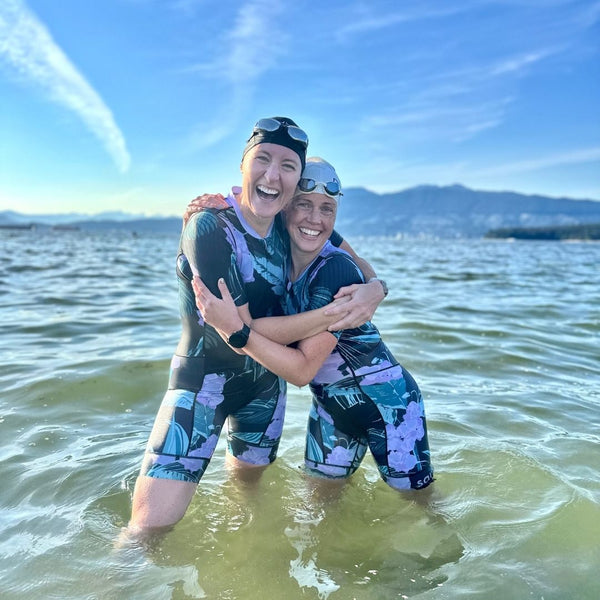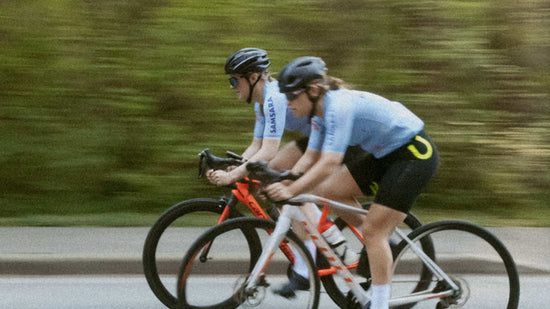Transitioning From Cyclist To Triathlete: How to go from single to multi-sport athlete

It’s no secret that there’s a fair bit of healthy(ish) ribbing between cyclists and triathletes. A quick search online pulls up more than a few forums dedicated to the heated–and hilarious banter. For instance, there’s this one that dives into why cyclists hate triathletes. The reason? Well, because triathletes are considered to have poorer riding etiquette, and are perceived as not knowing how to change a flat tire. And also, those tri outfits. And tri bikes. Basically, this picture sums up the feeling…
In return, triathletes chide cyclists because, well, they cycle… and only cycle.
As one triathlete defensively wrote, “Cyclists hate us. Because when they get off the bike they have a recovery drink, get a massage or are done for the day. We go for a run.” Or as yet another triathlete boasted, “triathletes can do three sports and chew gum at the same time.”
And so the banter goes, back and forth.
But let’s get real and speak some honest truth for a moment. For many cyclists, transitioning to triathlons is intimidating. Many great cyclists balk at having to conquer two other completely different sports. As they humbly point out, being good at cycling doesn’t necessarily make you an all-around athlete. In fact, like many high-performing athletes, we often learn to perfect one sport, at the cost of others. So for cyclists, diving into the world of multi-sport racing can be incredibly intimidating and involves a whole different approach to training.
Why Triathlons Are So Hard
1. The Swim
This is the part that gets most people about triathlons. We recently polled our global network of triathletes, asking them to rate their favourite of the three tri sports, and unsurprisingly, the order went like this: bike, run, swim. The swim portion is generally the part that most people loathe about triathlons. For that reason, it's called the great equalizer.
The swim portion of triathlons isn’t as physically demanding as the bike or run portion of the race – proportionally it’s actually the shortest distance – it is more technical, however. And not everyone grows up swimming.
Compared to running and cycling, swimming is a total body workout. You need to use more muscles. Plus, there’s the added restriction of oxygen. And that’s just talking about the physiological differences. Then, you also have to factor in the elements; especially if the triathlon is taking place in open water (as most do). Whether you’re lake swimming – where you’re less buoyant in fresh water– or in the ocean – with waves and tides to factor into your strokes. Plus, there are other swimmers to be aware of, too. Sometimes, physical contact comes into play. Straight up, there’s just a lot going on in a triathlon swim.
The best way to get comfortable with the swim portion of triathlon races is to practice. Practice in open water. Practice with your wetsuit. And most importantly, practice with other swimmers so you can learn to keep calm in stormy waters. Then, on race day, stay calm. Don’t get too excited in the fray. And if panic or doubt sets in, always, always come back to your breathing.

2. The Run
A lot of people turn to cycling to give their knees a break from running. Running is, straight up, much harder on the body. It is also, watt for watt, just generally harder. In order to keep going in running, you have to keep running. While in cycling, you can build up momentum to coast on flats or downhills, or – as is the case in most tri races – you can also draft behind other cyclists, which can save about 40% of your energy.
The running portion of triathlons is hard also because of the simple fact that it comes last, when most people are starting to lose steam. That alone should give you motivation to improve your running legs. If you can strategically push through this section, you just might be able to outlast the pack.
In short, as tough as it might be, being a good runner matters. There’s a reason why they dominate triathlons. As Lance Armstrong famously tweeted , Olympic triathlons are “a shampoo, blow dry, and 10k foot race.” So if you’re looking to improve your time, becoming a better runner is a must.

Olympic triathlons are “a shampoo, blow dry, and 10k foot race.”
3. The Transitions
Anyone who remembers their very first multi-sport race knows how tricky transitions can be. Your body has to go from swimming to cycling, and then cycling to running. Each transition is a whole readjustment of its own.
From swimming to cycling, for instance, you have to learn to regulate your breath. Many triathletes experience a temporary shortness of breath upon exiting the water due to the exertion and pressure required while swimming. Then there’s also the consideration that when you swim hard, lactic acid (lactate) accumulates in your leg muscles, making them more gushy on land. To avoid this, you should focus on regulating deep breaths (fully expelling air) while swimming. Also, you should try to kick more near the end of the swim to help flush the lactate build up from your muscles. Then once on the bike, start at a higher cadence – one you are comfortable with, of course – for the first 5 minutes.
Then from cycling to running, you have to adjust and steady your legs yet again. People especially struggle on this transition to stay on their feet and avoid collapsing. It’s called ‘cycling jelly leg syndrome', which happens due to over pacing – a common mistake athletes make when they go from cycling to running because your legs have been working at such a high cadence while cycling. A cadence that racers often mistakenly try to maintain for the run. The key is to go for smaller, slower steps at the beginning of your run. And work your running legs back up slowly.

Parting Thoughts
If you can take small steps to improve any of these three challenging bits in becoming a triathlete, you’ll be guaranteed to see big gains on race day. There is no doubt that triathlons will challenge you beyond the world of cycling. But they will also open you up to a whole new community of people that are showing up for the same reasons as any cycling race: to push themselves, reach new goals, and share in the positivity of a day’s good sweat.
✔ Swimming is challenging for most people. Just stay calm, and get through it.
✔ Running matters. Make the most gains on race day by becoming a good runner.
✔ Transitions require practice. Try block training and learn to switch seamlessly between sports.
If you want top performing gear for training and race day, check out our triathlon gear...
Samsara Triathlon Suits
Related Readings
- Tags: triathlon





